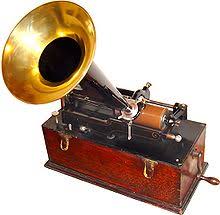The start of an exciting 3 part series!
A customer recently asked me to transfer some 5” reels of ¼” tape to MP3 memory stick, a recording made 58 years ago of his daughter singing away, memories that we all have. I heaved my 1963 Ferrograph 633 tape machine onto the bench and connected it to a PC. Away we went. Two massively different technologies, happily relating to each other, slowly falling in love.
Humans have been obsessed with recording and saving the human voice since around 1877, when a chap called Edison visualized a cylinder, about 8” long and 3” diameter. He covered it in a thin layer of tin and knocked up a mechanism that would rotate the cylinder. The other part of the machine consisted of a funnel mounted on a sort of lathe screw. At the narrow end of the funnel was a needle which pressed against the tin coated cylinder. As the cylinder rotated, hand cranked, a gear slowly moved the funnel along its length. Edison spoke loudly into the funnel, which vibrated the needle, which in turn left a modulated (wobbled) spiral grove on the cylinder. When the funnel was returned to the beginning of the cylinder and the needle rested in the grove, as it rotated, the recorded words could be heard! The first ever recorded words were “Mary had a little lamb, she also had a duck…..” Well sort of, I added the duck bit.
This was all good, but the cylinders were bulky, hard to copy and quality of sound was rubbish. Edison lost interest in this and went off to invent the light bulb. In order not to infringe on patents, in late 1899, Mr. Berliner developed a system that used a similar horn, funnel arrangement, but this time the recording was on a flat disc with the grove spiral running from outside to the centre. The metal disc was coated with a hard ink and when dipped in acid, the surface was eaten away, leaving a clean grove. With a few developments, the disc could be now used as a “Master” to make copies. It was placed in a steam press where it was squeezed onto a hard shellac compound, similar to the old 78s some of us remember!
Over the following 15-20 years, the technique was developed and standards such as the 78 RPM, 10” and 12” disc were agreed. Popularity grew in wanting to own a gramophone. Recordings of Opera and Dixieland jazz were being sort after. But, the whole system was still very mechanical, no electronics and microphones as yet. The big horn used to collect the sound to be recorded, dominated the recording studio.
Let’s take trying to record a small ensemble. Different instruments produced different volumes of noise, so, the loud instruments such as drums and piano, would be placed furthest from the horn, woodwind players would be closer and the poor old violins would have their heads stuffed inside the horn, as high frequencies did not record well. Bass notes were also a problem. Double Basses didn’t provide enough volume, so instruments like Tubas, bass and contrabass Saxophones were used to add a bit of grunt.
As electronics and valve technology stormed ahead from the mid 1920s, amplification, microphones made record recording much easier. The band, orchestra and singers, could have their own microphones and now a “balance” could be made. Recordings were still made by “cutting” a metal disc. This was now the master from which other originals and copies could be made. Development of the “cutting head” was at the forefront, both in the US and Britain. Columbia, Victor and Western Electric had their own designs, but it was a British chap called Mr. Blumlein, working with HMV and EMI, who came up with a high quality system, whose principles are still used today. So there.
When in the recording studio, “cutting” a disc was not for the feint hearted. The disc itself cost around 40 quid in the ‘50s, plus technician and producer’s time. You set the band up, a quick run through of what was to be recorded. Then, on with the “Red Recording” light and it had to be done in one take. No tape editing or autotune! Any cock ups, duff notes, meant a wasted disc and studio time, adding up to a lot of money. If a musician made mistakes, he would be black listed or worse. I had the privilege of playing Sax in Ken Mackintosh’s dance band and some of the stories as to what went on were legendary!
Next time, how Tape Recording changed things.
Seth Pittham




